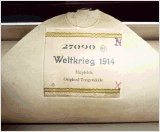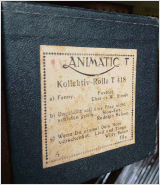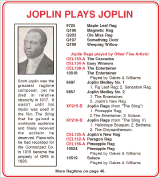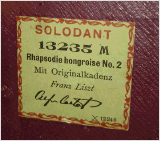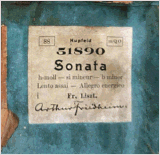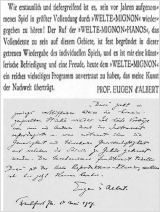Piano rolls - titles and artists
The titles that were available on piano rolls followed the respective prevailing taste that was quite different on the regional level – i.e. in Germany it was different from the USA. The manufacturers also desired to offer a more interesting and broader spectrum of titles than the competitors. Hupfeld boasts early on its capacity to offer the most important and most complete piano literature, „the largest musical treasure trove“ - while Aeolian rather advertises the large selection of different popular titles. The focus turned more and more to cutting-edge titles, beside the classical repertoire. There were also frequent attempts to achieve an advantage over the competition by the exclusivity of certain titles - like in the accompanying ad of F.I.R.S.T..
Hupfeld Weltkrieg 1914
The political situation had an impact on the musical taste, too - marches (Kaiser Friedrich marches, etc.) were strongly present in almost every repertoire – especially before 1919. Hupfeld created a special heroic sound painting, "World War 1914", with accompanying texts for all phases of going to war. Title from the sections “classical, opera & operetta, marches, sacred, pop, dance and light music” were common. The typical repertoire of a pianola comprised 30-50 piano rolls - usually from all sorts of music.
Welte top 10 most liked piano rolls
The book "Welte-Mignon-Notenrollen" by G. Dangel and Hans W. Schmitz contains an evaluation of the most frequent titles which were found in piano roll repertoires of about 60 Welte-Mignon owners. The top 10 are: Liszt's Liebestraum Nocturne No 3, Paderewski's menuet, Wagner's Isolde's Liebestod, Liszt's Hungarian Rhapsody No 2, Beethoven's Moonlight Sonata, Strauss' Voices of Spring Waltz, Chopin's Ballade No 3, Beethoven's Pathetique, Wagner's Rheingold Valhalla, Chopin's Ballade No 1. Even though this is certainly a Welte-Mignon top 10 only, it may resemble the repertoires of other German owners before 1930. Add to that lots of German pop songs after 1915 - in potpourris or on collective rolls, such as for the Hupfeld Triphonola.
QRS repertoire
The most popular titles in the USA and the UK are also represented by Chopin, Beethoven, Liszt and Wagner - besides, obviously, the American light music of the 1910s to 1930s: ragtime, jazz, blues, swing, etc. A few of these titles - but rather rarely - are found in the repertoires of the contemporary German pianolas, because this American music had not entered Germany yet. It came to Germany on a few piano rolls after 1945 only. Then the rolls of QRS continued to offer many of the modern titles for the pianola - the group of owners of these pianolas had much shrunk till then, however.
Special interpretations of pianists
Since the way to play a piano was much different in 1900-1930, very interesting titles with sometimes very different performances are found among the recorded piano rolls. The pianists obviously enjoyed the freedom of performance up to the transformation of entire passages. The discussion about faithful rendition has prevailed - there is probably no definite opinion to be accepted. Like Beethoven who is said to have long refused to set down his pieces on paper, so as to avoid misinterpretations, and he tried to avoid this by introducing extremely precise terms for how to play. Other composers heard the performances of their pupils and sometimes discovered the actually desired sound there - as described by Vladimir Horowitz when he once played a piece of S. Rachmaninoff in the latter's presence. A title of many interpretations is F. Liszt's Rhapsody No 2.
Composers playing their own works
Some composers used about 1910 the possibility to record their performance on piano rolls to preserve the desired performance unambiguously for future generations. A. Ord-Hume mentions in his book "Pianola" an example of the title La Cathedrale Engloutie - Claude Debussy recorded his own piece at Welte's (roll 2738), and it turned out that he had forgotten an important tempo information, "doppio movimento", on the published sheet, so that this passage sounded much different when the composer played it on the piano roll. With regard to that, titles recorded by the composers themselves are extraordinarily interesting. As are those piano rolls that were recorded by immediate pupils of the composers who had died before this recording method was available. This applies, for example, to the Sonata B minor by Franz Liszt, recorded by his pupil Arthur Friedheim in Hupfeld (rolls 51890-51891), whose performance Liszt called the best one.
Pianists statements on their recordings
Although those piano roll titles that contain recordings of the composers and pianists are rare contemporary documents, different opinions about their authenticity are permissible. There are many examples of pianists who found their own recorded piano rolls quite dreadful when replayed. Often this may probably be attributed to the bad condition of the reproduction instrument - however, some piano rolls have simply been processed with low quality. Not all pianists were ready to invest time into post processing after recording. S. Rachmaninoff's statement on the Ampico recording, quoted on the first page, was probably made after he listened to the original reproduction of his play right at the recording grand - and this sounded certainly very identical. The sometimes over-enthusiastic statements of the pianists concerning the different reproduction instruments should generally be taken with some grains of salt, because they were very often motivated with a lot of money. Not only Eugene d'Albert signed such claims of uniqueness for several different systems. Whatever, the pleasure of listening to different titles on different pianola systems and to discover how the sound of the same pianists changed over time will remain.
List of rolls being recorded for different Manuf.
Many pianists and composers of that period recorded their titles on different systems. This was certainly due to various reasons - the technical innovation of the respective systems, the possibility to address many owners of these systems and, of course, the generous fees. When deciding for one of the pianola or reproduction systems, it is interesting to examine which titles are available for this system. In, among other things, this list [241 KB] is an overview which reveals that some pianists and composers may be enjoyed only on certain systems. In particular the Hupfeld 73 note Phonola will gain interest with regard to its repertoire, because there are both rare titles and a very huge repertoire available. If you are looking for certain titles or would like to ask about certain composers or pianists, please, contact us. We always offer a large selection of piano rolls and can refer you to additional sources.


